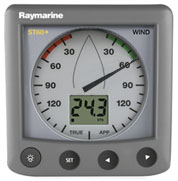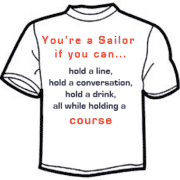Learning to hold a straight course
One issue that appears most often with new sailors learning to sail is focusing too much attention on the electronic wind meter or the wind direction indicator (the pointy arrow thing at the top of the mast).
The windmeter above which is installed on most modern sailboats shows that the wind is coming from 60 degrees off your bow and is blowing at 24.3 knots (Hope your sails are reefed in). You should be sailing on a close reach. Do you know if it is starboard or port? See the answer at the bottom of this post.
Imagine driving down the highway looking at your speedometer for more than 10 seconds. You would surely have an accident. Now relate this to looking at your wind instruments. As with a speedometer in a car, you only need to look at them for long enough to gain the information it is telling you (IE check wind instruments for about 1 second every 10 seconds). The rest of the time your eyes should be up out of the boat and looking at your surroundings and the horizon taking note of which tree, house, cloud, island etc that you are sailing towards. You make your course corrections when looking out of the boat then you check the wind instruments to see if you’re back on the desired wind angle. If not then lift your head out of the boat again and make a new course correction. In this manner you can judge exactly how much your boat is turning.
If you make course corrections while looking at the wind instruments you will tend to over shoot every time. Think about trying to drive down a highway using a compass only and stay in a straight line or make a 90 degree turn using a compass. Not really possible or practical yet the tendency to do this when sailing is high. Rid your self of any such habit from day 1.
People ask “well what if you’re on the open ocean and there are no objects to point at”. Don’t worry – by the time you get to the open ocean you’ll have the “FEEL”.
This discussion is equally similar when you give the helm over to a novice. The best thing to do to a novice is to start them out by having them aim at something so that they can get used to sailing in a straight line using small 1/4 turn max corrections on the wheel. Trying to explain to someone who has never taken the wheel about the wind indicators is pretty pointless.
As you’re becoming more confident in your sailing abilities you can test your self out on a clear steady wind day by looking at the wake you’re leaving and ensuring it is in a straight line. This will tell you if you’re tending to slightly over steer and keeping focused on the job at hand.
Remember this:
You’re a sailor if …
you can hold a course,
and hold a drink,
and hold a conversation.
And if you can do that while telling a joke – then you’re advanced.
If you liked this article, please Share it or Digg it below. It helps spread the word of NauticEd.
Starboard!





